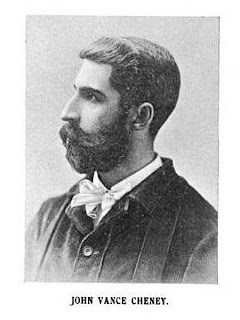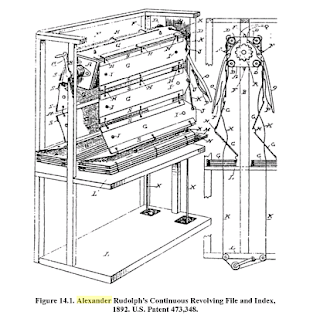Library Research Project:
The San Francisco Public Library
Melissa Woods
San Jose State University
LIBR280_12
13 May 2013
Professor Beth Wrenn-Estes
California’s Public Library Efforts
San Francisco – Queen of the Pacific
The Meeting
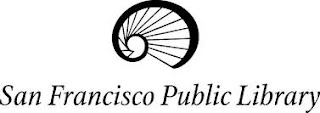 |
| Current Library Logo |
The
San Francisco
public library’s history is one of rocky beginnings. Established in 1878, the library was born out
an early literary culture, enormous wealth at a time when the free public
library was increasingly popular. What
is interesting is how one can trace the history of the public library movement
in America using the
evolution of San Francisco’s
own library system. We can see how the
public library got its start, but also how the movement evolved through the
early twentieth century by analyzing the library’s establishment, its staff,
and even the buildings that housed the collections. We can see an evolution from the librarian as
the custodian to the librarian as a community educator and advocate. And we can also see how the library started
as a tool for education and also a tool of suppression. San
Francisco’s library offers a slice of American history
that shows what it took to begin the public library movement and what it takes
to keep it moving.
The Free Public Library Movement
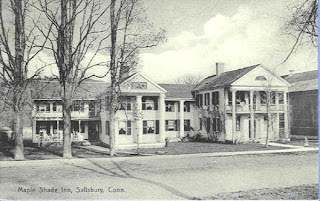 |
| Salisbury, Connecticut |
The first free
public library was built in Salisbury, Connecticut in 1810, but it wasn’t until the Boston
Public Library opened in 1854 that the idea of a tax-supported public library
became an incredibly influential in the America (Wiley, 1996). Two major players in the founding of the
Boston Public Library wrote a report which would become, according to Wiley
(1996), “the Magna Carta of the public library movement, setting the tone for
American public libraries for the next half century or more.” The report argued that while there were many private
libraries at the time, those libraries were inaccessible to the masses and
therefore did not serve the needs of the public (Wiley, 1996). It also added that public libraries would be
a supplement to public education systems that only taught up to a certain point
and then offered no access to further education (Wiley, 1996). And so, in areas where there were enough
community resources, dense population, civic pride, and the desire to conserve
the historical record, the idea of the free public library spread (Garrison,
1979). While this is part of the story,
it fails to recognize that there were other, less altruistic reasons that the public
library became popular. For instance,
around the time that the public library movement idea was spreading, there was
a period of labor unrest and mass discontent which put the ruling white,
upper-class, male gentry on a shaky ground (Garrison, 1979). The public library became a way to respond to
the issue by equalizing education rights and reducing lower-class alienation
(Garrison, 1979). Furthermore, Garrison
(1979) argues that the public library was also a way for the ruling body to
practice social control as they were the governing body of library purchasing
and sometimes censorship (Garrison, 1979).
So while the argument of the education of the masses was solid, it may
have appealed to the ruling class for several reasons. Regardless, the idea spread throughout the Americas and
eventually found its way to the West.
California’s Public Library Efforts
California was swept up by the public
library movement though the idea proved quite difficult to implement. This was because the legislation needed to
generate funds for the library was difficult to promote (Held, 1973). As early as the 1850s, there was evidence
that California
cities supported the idea of legislation that would create a tax to fund a free
public library. But, it would not be
until the 1870s that attempts at legislation would begin in earnest (Held,
1963). Cities like Sacramento
and San Jose made legislative attempts, but San Francisco and Los
Angeles were the only two cities that were successful
in creating legislation that would directly
result in the rise of a city library
(Held, 1963).
 |
| CA Golf Rush Relief Map |
San Francisco – The Queen of the Pacific
Nineteenth
century San Francisco
was a time of great change. The city
evolved from a sleepy town to a boom town, and eventually a major city, in
almost the blink of an eye. And the
credit of this mass migration to the West is given to one thing; gold. Though the San
Francisco Bay had been
explored as early as 1769, it wasn’t until 1835 that the town of Yerba Buena was born (“San Francisco,” n.d.). That was when an English pioneer named
Capitan William Andrew Richardson set up the first dwelling, a tent made from
four planks of redwood and a ship sail (“San Francisco,” n.d.). At the time that Richardson
built his tent, the US did
not yet own the area and wouldn’t for another eleven years (“San Francisco,” n.d.). But after eleven years of fighting over the
territory, the US Marines declared the area the property of the United States and named it San
Francisco (“San Francisco,”
n.d.). The settlement was slow growing
in its early years. In fact, the
permanent population did not exceed more than 50 people until 1844 (“San Francisco,” n.d.). In 1848, just before the discovery of gold on
the American River, the town had grown to about 200
homes which were inhabited by about 800 settlers (Bacon, 2002).
When James Wilson
Marshall discovered gold from the American
River at the site of
John Sutter’s
sawmill an international frenzy was sparked and thousands flocked to the area
in search of riches (“California,”
n.d.). By August of 1848, the population
had grown to include 4,000 gold miners and by 1849 San Francisco boasted a population of 25,000. (“California,”
n.d.; Bacon, 2002). At the time, San Francisco’s culture
was one of diversity with elements of both opulence and seedy behavior. Miners and sailors would spend their time in
gambling dens or brothels and in some cases would pay top dollar just to have a
woman at his side (Bacon, 2002). But
those that truly struck it rich, often by establishing businesses related to
mining, were becoming civic leaders and building opulent mansions along the
city’s hills (Bacon, 2002). San Francisco was also
extremely literary for the time. By the
middle of the 1850s, the city had a well-developed book trade and more
newspapers, in more languages, than major metropolitan cities such as London (Wiley, 1996). And, according to Wiley (1996), “there were more
college graduates in early San
Francisco, some said, than in any other American
city.”
 |
| Broadside from the Gold Rush |
 |
| Military Ball in S.F. - 1863 |
In the 1860s there
was a second wave of immigration into San
Francisco which brought both sophistication and racial
tension (Wiley, 1996). Called the ‘Queen
of the Pacific,’ by the end of the 19th century, there were palatial mansions, the
largest luxury hotel in America
at the time, the Palace Hotel on Market
Street, and a very opulent city hall (Wiley, 1996). But with the end of the Civil War, the city
was going through an economic downturn (“California,”
n.d.). This spurred labor unrest and a
general distrust in Chinese laborers leading to the Chinese Exclusion Act of
1882 which barred Chinese immigration until 1902 (“California,” n.d.). It was amidst this tumultuous time that the
city decided it was time for a free public library.
 |
| Chinese Miners |
The
origins of the San Francisco Public Library can be traced to a meeting that was
held by concerned citizens of the city in the summer of 1877 (San Francisco
Public Library, 2013). California’s
senator, Senator Rogers, became the chief spokesman for those that were behind
the library campaign and he has been credited with personally collecting data
about libraries in the US
and overseas and he circulated that data around San Francisco in an effort to drum up support
for the campaign (Held, 1973). The
meeting was held at Dashaway Hall on Post
Street in San
Francisco and with the hopes of sharing the data that
had been collected and establishing a need for a public library (Wiley, 1996). Rogers
placed Judge E. D. Sawyer in charge of the meeting and it was well attended
(Wiley, 1996). Among those present, two
of the more prominent figures in the history of the library was Andrew S.
Hallidie and Henry George (Held, 1973).
Hallidie, who is better known as the inventor of the cable car, was the
head librarian of the Mechanics’ Institute Library in the city and he continued
to be an advocate for the free public library throughout his life (Wiley, 1996). Mr. George, another staunch advocate of the
free library movement gave a report of information about libraries in the US and Europe
at the meeting (Held, 1973). The report
stated that: “(1) People were willing to support public libraries with taxes.
(2) A public library was not able to exist on subscriptions and donations. (3)
A public library led to an increase in reading on the part of the public. (4)
The average cost per volume of a good library was $1.25. (5) Libraries were
often augmented by donations of private collections” (Held, 1973). The culmination of the meeting was a
resolution and proposed legislature (called the Rogers Act) that would later be
passed and signed by Senator Rogers on March 18, 1878. The legislature authorized “any incorporated
city or town to levy a tax not exceeding one mill (one-tenth of one cent) on
the dollar of assessed property” (Held, 1973).
The fact that the legislature included all of California was extremely significant as it
solved the issue that several cities had of being unable to pass their own
legislature (Held, 1973). The other
interesting fact about the legislature was that it called for the San Francisco
Library to be governed by a
self-perpetuating board of trustees that would supposedly keep the library from
“the general corruption of city politics” (Wiley, 1996).
 |
| Dashaway Hall |
 | |
| Political Cartoon (Kearney not pictured) |
By
analyzing the meeting, we can begin to understand the nuances of the free
public library that Garrison suggested. The
call for a public library came at an extremely tumultuous time in San Francisco’s history. The completion of the transcontinental
railroad in 1869 coupled with a depression that struck Eastern States in 1873
created a large influx of population of unemployed men and women in the West
(Wiley, 1996). Even worse, between the
years of 1870-1875, an estimated 80,000 Chinese immigrants arrived in the area
(Wiley, 1996). Needless to say, there
was a large amount of men and women who competing for work which brought about
the ‘terrible seventies’ in San
Francisco (Wiley, 1996). Labor unrest was triggered by people who were
resentful of the economic overlords and disappointed by crushed dreams of easy
riches (Wiley, 1996). And much of this
unrest, unfortunately, was targeted toward Chinese immigrants. In fact, the same year that San Franciscans voted
to establish the San Francisco Public Library, there was a major riot in the
city where a group of protesters broke off and ran towards the docks attacking
Chinese people and Chinese-owned shops along the way (Wiley, 1996). At the meeting, there were arguments made suggesting
that the library would be about educating the masses while also controlling
some of the labor unrest. Dr. George
Hewston suggested that a public library would “be open to all classes, but
principally frequented by the poor; that the man in corduroy is treated with
the same courtesy as the rich man in broadcloth…and that charm of the place is
its perfect freedom” (Wiley, 1996). But
in the same speech, he remarked that the library would “do more to overcome
hoodlumism than the extremest rigors of the law” suggesting that, yes, the
library would be good for the masses, but at the same time, it will also help
reduce some of the labor unrest. Another
attendee, Denis Kearney, a rioter who was the head of the President
Workingmen’s Party, remarked that “one educated man is worth a whole Committee
of Safety and not nearly as liable to shoot his neighbor” (Wiley, 1996). So while it is not said outright, we can see
that many were in agreement that a great way to solve the labor unrest and
possibly turn the population’s anger away from the ruling party would be to
construct a public library. This is
further evidenced by the fact that the founders were all part of the white,
upper-class, male gentry of the city.
The
board of trustees that was established to run the San Francisco Public Library
was made up of eleven men. They were
George H. Rogers, John S. Hager, Irving M. Scott, Robert J. Tobin, E.D. Sawyer,
John H. Wise, Andrew J. Moulder, Louis Sloss, A.S. Hallidie, C.C. Terrill, and
Henry George (Held, 1973). The board had
many things in common. Firstly, they
were all white, highly educated male members of San Francisco. Many of them were lawyers, judges, and State
Senators or even all three, like E. D. Sawyer.
A transplant from New Orleans,
Sawyer started his career as a lawyer who dealt mainly in mining disputes
(Shuck, 1901). In 1853, at the Whig
convention, he was nominated and elected as a democratic State Senator (Shuck,
1901). After his retirement from politics,
Sawyer moved back to San Francisco
and became a judge, served as an educational director, and became a prominent
member of society (Shuck, 1901). The
trustees were civic minded and were often involved in California politics like John S. Hager. Hager, originally from New Jersey, was a delegate at the first and
second California Constitutional Conventions, though he was not officially
listed in the first (Vasar & Meyers, 2013).
As one can see, many of the trustees were not originally from San Francisco. Like the
majority of the city, they moved after
news of the Gold Rush and they profited from mining or from working with
miners. Take Irving M. Scott. He was an engineer and draughtsman who worked
for the Union Iron Works creating machinery that would make mining more
efficient (New York
Public Library, 2013). While this was
his main career, he is best known as the head of the project which built the
battleship Oregon, the first battleship ever built on the
Pacific Coast (New York Public Library, 2013). Some members, like
Robert J. Tobin were
involved in several social and civic organizations. According to his obituary written in the San Francisco Call (1906), Tobin was a
judge, a police commissioner, a charter member of the Society of Pioneers, and
one of the Incorporators of the Hibernia Bank which started in 1859. Lastly, the trustees were literary men. Some, like A.S. Hallidie, were already
working in libraries and at least one of the members, Henry George, was a
newspaper man. George moved from Pennsylvania with his
family and got a job as a
typesetter (Henry George Historical Society,
2009). After the death of Abraham
Lincoln, he wrote several editorials which got him noticed, and he eventually
got a job at the Times (Henry George
Historical Society, 2009). Within a short period of time, George was
the managing editor for the newspaper (Henry George Historical Society, 2009). These men were extremely committed to a free
public library but not every powerful member of San Francisco was like minded and as a
result, the main library had very rocky beginnings.
 |
| E.D. Sawyer |
 |
| John Hager |
 |
| Irving M. Scott |
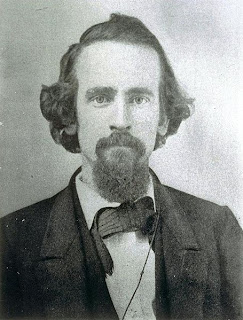 |
| Henry George |
Despite
the city’s enormous wealth, there was little support in San
Francisco and in the US in general for government
funding of public institutions. “It was
an era across the nation when private enterprise prevailed, and little
attention beyond the funding of public schools was given to investment in
public institutions” (Wiley, 1996). This
mentality created financial difficulties at the onset of creation of the
library. After the Rogers Act passed in
1878, the trustees requested that a tax by levied of 3/10 of a mill and an
appropriation of $75,000 be given to the library to begin operations and to
start the purchasing of the library’s collection (Held, 1973). San
Francisco city officials disagreed with the amount and
the library was given an appropriation of $24,000 instead (Held, 1973). The trustees deemed the sum inadequate but
opened anyway, deciding to donate some of their own resources until the end of
that fiscal year hoping that San
Francisco’s Board of Supervisors would raise the
appropriation after the library had already opened and shown it was successful
(Held, 1973).
Between
the library’s opening in 1878 and 1906 the main branch moved locations three
times. This was a period that was marked
by continued financial struggles and high staff turnover rates. But the library was instantly successful with
its users as we can see from the library’s records. If we look at card membership statistics during
this time, we see the library’s steady growth.
In 1890, there were 10,354 library card memberships active (San Francisco Board of
Supervisors, 1895). After a small
downturn, membership grew steadily so that in 1895 membership had grown to
16,411 (San Francisco
Board of Supervisors, 1895).
Library cards were
issued for two year periods and, until 1901, only one book could be checkout
out at a time (San Francisco Public Library, 1900). After 1901, a time of great change in the
library field, you could apply for a special card which would allow the holder
to borrow more than one (San Francisco Public Library, 1900). And in 1902, the library began stamping their
books with the date they were due rather than the date that the book was
checked-out (San Francisco Public Library, 1900).
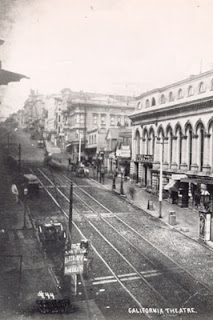 |
| Pacific Hall |
Public libraries
in California
were usually located in one of two places.
First, as the city government was considered a patron of the public
library, often a space would be provided in the city hall (Held, 1973). However, these free spaces were often
inadequate for the needs of the library and they were often forced to use what
little budget they had to rent a space large enough to accommodate their needs
(Held, 1973). San Francisco’s public library was no
different.
In 1879, before
the library had received any money from the state, a room was rented on the
second floor of Pacific Hall on Bush and Dupont (later renamed Kearny) Streets (Wiley, 1996; San Francisco
Public Library, 2013). They removed a
stage that was in the room, laid fresh oilcloth, touched up the fresco’s that
were in the room, and constructed a small office in what would be the reading
room (Wiley, 1996). Shelving was built
and 5,000 books, which were borrowed, donated, or bought on credit, were put on
the shelves. A newspaper reading area
was added in the main gallery and lastly, a wire screen was installed in front
of the bookshelves to assure only employees could have access to them (Wiley,
1996). At the establishment of the
library, there were so few books that the library did not grant borrowing privileges
and would not for several years (Wiley, 1996). The library opened with a
ceremony held on the evening of June 7, 1879 (Wiley, 1996).
Even though there
were no borrowing privileges, the library was an instant success. It was reported that in the twenty-one days
after the formal opening, 18,000 people visited the library (G. Bosc, 1968). Because of the library’s success, the budget
was immediately doubled and they increased the volumes in the collection to
30,000 (G. Bosc, 1968). Within ten
years, the library had outgrown Pacific Hall and begun looking for a new,
larger, space. Joy Lichtenstein, a
library employee since 1886 described the library the following way:
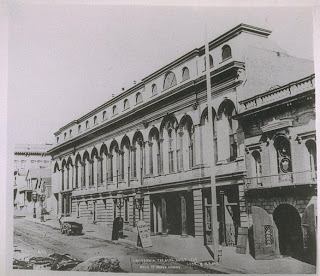 |
| Pacific Hall |
When I entered the
employment of the library it was on Bush
Street, on the north side above Kearny…The library was up one flight of
stairs. As you entered a long hall there
was seated at the entrance an old man, in fact there were two of them –
combined janitors and doorkeepers. The
one in attendance would hand you a brass tag, fairly large, which you carried
in with you and which you absolutely had to deliver before you could
leave. The library itself was in back of
a tall wire screen and there were no books which the public could touch except
by making out applications. The wooden
bookstacks rose to the ceiling, and the boys scrambled around by means of
sliding ladders which resembled those used in shoe stores. The books had class and shelf numbers but the
Decimal System was still far in the future.
The catalogs were printed and very much out of date. The public secured books…with a pink or white
oblong slip…there were handed through openings in the fenced off portion and
three ladies were always in attendance.
They were ladies who had secured their positions by means of influence
not political. They were not bookish and
of course the boys were not; so it was a sort of hit or miss proposition for a
member of the public to procure a desired book - California Library Bulletin, June 1950 (Wiley,
1996).
In 1889, the
library moved to the Larkin Street
wing of City Hall though at the time there were already discussions underway to
build a separate building for the main library (G. Bosc, 1968). As these discussions took several decades,
the library was strapped for space again and in 1894 it moved to the third
floor of the McAllister Street
wing of City Hall (G. Bosc, 1968). It
remained at this site until the earthquake and fire of 1906 (Wiley, 1996). Interestingly, in 1903 the library was able
to purchase land which was intended for a new main library (Wiley, 1996). But the real estate would be disputed for
many years, and the library would not move into a separate building until 1915
(Wiley, 1996). Until then, the library
was renting space to house its main collections.
 |
| Main Branch (top) and Branch (bottom) |
Some interesting
services that were started in the library between 1878 and 1906 were a
periodical room started in January of 1895 and a Juvenile department which
began in October of the same year (G. Bosc, 1968). The Juvenile department replaced what was the
‘ladies reading room,’ in 1897, which moved from its original space on the
second floor of the building, to the ground floor (Wiley, 1996). The ladies reading room, according to the San Francisco Call, had tables where the
women could sit and on the tables were travel books and other literature that
would “take from them the desire for trashy literature” (Wiley, 1996).
The
first librarian ever hired was Albert Hart (Wiley, 1996). He was hired in 1879 with the understanding
that he would not be paid until the library could secure funding (Wiley, 1996). Opening a library without pay and without
funding took a toll on Hart and within the first fiscal year he resigned
(Wiley, 1996). He was replaced by
Charles Robinson who also resigned after seven months, claiming overwork
(Wiley, 1996). In 1880, with enough
books to finally become a circulating library, the trustees hired Frederic
Beecher Perkins (Wiley, 1996). Perkins
was a member of the Beecher
family and he was cousin to the famous author Harriet Beecher Stowe who wrote Uncle Tom’s Cabin (Wiley, 1996). He was known for his rigidity and was even
quoted as saying “a library is not for a nursery; a lunch-room; a bed-room; a
place for meeting a girl in a corner and talking to her; a conversation-room of
any kind; a free dispensary of stationery, envelopes and letter-writing; a free
range for loiterers; a campaigning field for mendicants, or for displaying advertisements;
a haunt for loafers and criminals” (Wiley, 1996). Though rigid, he was also inventive. Perkins claimed at least two innovations for
the public library while employed at the library. First, he advocated painting the call numbers
directly on books rather than using paper labels (Held, 1973). He also developed a numbering system for
patrons that involved a revolving rack for request cards presented at the desk
(Held, 1973). This allowed for a strict
enforcement of the ‘first come first served’ principle (Held, 1973). Unfortunately, Perkins’ rigidity got the
better of him and he resigned after being fined for ‘manhandling’ an unruly
child in 1887 (Wiley, 1996).
John Vance Cheney,
was hired after Perkins left (L. Bosc, 1968). Cheney, who was a poet, essayist,
and librarian, was born and educated in New
York (“Cheney, John Vance,” n.d.). After moving to San Francisco, he was a postal clerk briefly
before assuming the position at the library (“Cheney, John Vance,” n.d.). While he was librarian, he oversaw the opening
of the first two library branches and hosted an American Library Association
Conference in 1891 (“Cheney, John Vance,” n.d.). After Cheney resigned in 1894, George Thomas
Clark and was hired (Wiley, 1996). Clark
and his assistant Joy Lichtenstein left the library shortly after the
earthquake in 1906 (Wiley, 1996).
According to Lichtenstein, “Clark had
been a difficult man, remote and taciturn – ‘not a man of very attractive
personality’” (Wiley, 1996). He was head
of the library for twelve years and in that time the library grew to be the
eighth largest library in the United
States (Wiley, 1996). Clark left in 1906 to become the head
librarian of Stanford
University (Wiley, 1996).
Little
is known about the assistants of the library from its beginning to the 1906 earthquake
though there were some prominent library assistants working during this
period. For instance, Joy Lichtenstein, a
rare San Francisco native, started working at the San Francisco Public library
in 1886 (Cutter, 1904). He was an author
and also served as president of the California Library Association in 1904
(Cutter, 1904).
There
was also Alexander Rudolph who was a library assistant in the 1890s (Buckland,
2006). He was the inventor of the
Rupolph Continuous Index (G. Bosc, 1968).
This was an automatic cataloging machine that was designed to hold up to
12,000 catalog entry cards in an endless chain (Davis & Wiegand 1994). The cards were held on pressboard sheets
which would display 175 at a time and were rotated beneath a glass plate at the
top of the machine when a user turned the handle (Davis & Wiegand
1994). While used for catalogs in areas,
such as Russia,
until the 1930s, it was generally unsuccessful (G. Bosc, 1968). This was due to the lack of capacity,
flexibility, and limited access compared to the card catalog (Davis & Wiegand
1994). While both of the above examples
were male library assistants, many of the library assistants were women. For instance, in the 1894-5 municipal report
for San Francisco,
all five of the library assistants were women (San Francisco Board of
Supervisors, 1895).
As far as the
salaries for the employees, it is difficult to tell from the municipal reports
what the average salary of a librarian was in San Francisco between 1878 and 1906. We can see that that the library did not
focus most of its spending on its staff in the early years. In fact, as stated earlier, the first
librarian did not even get paid, initially.
In the second fiscal year that the library was open, 1879-80, only $7,841.70
of the $38,615.04 that was spent was allocated to staff salaries (San Francisco
Board of Supervisors, 1879-80). There
was no indication of how the money was split amongst employees. In the fiscal year of 1894-5, the total that
was spent on salaries was $22,265.35 with roughly $1,500 being spent in the branches
and the remainder at the main library (San Francisco Board of Supervisors, 1895). At this time there were four branches and the
main building, with a total of thirty-eight employees (G. Bosc, 1968). Though
it is difficult to tell from the municipal reports, we do now that in 1894 the
library’s employees were being paid $48.95/month less than the average city
worker in San Francisco
and they worked longer hours.
Andrew Carnegie – Dirty Money?
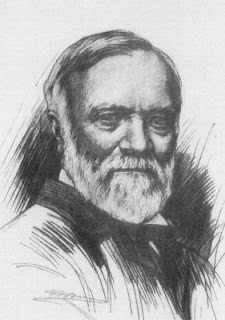 |
| Andrew Carnegie |
While discussions
were underway to establish a separate main library, in 1901, the library was
offered a Carnegie grant for library buildings which totaled $750,000 (G. Bosc,
1968). The trustees secured a commitment
to spend the money on a new main library as well as opening new branches. But the proposal to accept the money did not
go smoothly. The San Francisco Labor
Council quickly opposed accepting the Carnegie grant because the gift was
considered a “presumptuous claim of a wealthy nonresident to dictate our
municipal policy in the assumed name of philanthropy” (Wiley, 1996). Additionally, the money was thought, by the
Labor Council, to be acquired by questionable means through the sale of war
goods to the United States
at “extortionate rates” (Wiley, 1996). A
library constructed with Carnegie money, the Labor Council concluded, would
‘stand as a perpetual charge against the morals of the community’ (Wiley,
1996). Despite the staunch objection by
the Labor Council, San Francisco’s
Board of Supervisors voted to accept the grant.
They also put a $1.647 million bond measure on the ballot in 1903 to
match the Carnegie grant and to provide funds for the new main library (Wiley,
1996). Though nothing would be settled
until years later, it was in 1901 that the discussions for a new main library,
and indeed a new Civic
Center would begin in
earnest (Wiley, 1996).
| 1893 Colombian Exhibition in Chicago |
At the turn of the
twentieth century, the City Beautiful movement was sweeping the nation. The City Beautiful movement began with White City
and architect Daniel Burnham at the 1893 World Colombian Exhibition in Chicago
(Casey, 2012). A response to failing
urban life, the hope was that beautification of the city would improve social
issues and inspire civic loyalty (Casey 2012).
San Francisco’s
move to improve itself took the form of former Mayor and library advocate James
Phelan. He invited Burnham, the father
of the City Beautiful movement, to San
Francisco in 1904 and persuaded him to draw up new
plans for the entire city (Casey, 2012).
Burnham complied. Part of these
plans included a new Civic Center that would be the center of the city and would
include features such as an extension to Golden Gate
Park,
called the panhandle (Wiley, 1996). The
plan included a new library, but the location was hotly contested. Phelan wanted it to be across from the
panhandle bounded by Fell, Franklin,
Hayes, and Van Ness Streets, but the Board of Supervisors felt it should rest
at the south side of City Hall (Wiley, 1996).
Phelan ultimately won his battle and the new site for the main library
was approved in 1905 (Wiley, 1996). The
beautification of the city was never fully realized, however, due to the
infamous 1906 earthquake.
Earthquake and Fire
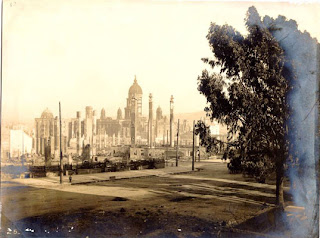 |
| Devastation of Earthquake with City Hall Background |
At 5:13am the
morning of April 18, 1906, a major earthquake raced in a southeasterly
direction at 7,000 miles per hour down the San Andreas Fault, severely damaging
San Francisco
(Wiley, 1996). The earthquake lasted
about 1:30 minutes, but because much of the city was built on landfill and it
was constructed poorly, many houses were destroyed (Wiley, 1996). Immediately after, several fires sprang up and
further decimated the city (Wiley, 1996).
Over 4½ square miles of the city was leveled, 250,000 lost their homes,
and around 3,000 people died as a result of the earthquake and fires (Wiley,
1996). The main library at City Hall
lost 138,000 books and newspapers because of the Ham and Eggs Fire, so called
because a woman, who was trying to cook her morning meal using a damaged
chimney, started the fire (Wiley, 1996).
At the time the earthquake hit, there were 15,000 books on loan; only
1,500 were returned (the last one was returned in 1981). And though the main library was destroyed,
there were four branches remaining and around 25,000 books left undamaged
(Wiley, 1996).
Between
the years of 1907 and 1920 the library grew immensely. For instance, in 1906 there were a total of
25,000 volumes in the collection with 25,702 circulated items (G. Bosc,
1968). There were four branches and
9,595 cardholders (G. Bosc, 1968). But
by 1917 the library had grown to 191,960 volumes with 1,183,754 circulated
items (Bosc, G., 1968). The library went
from four to seven branches (there had been eight in 1906) and there were
57,966 volumes (G. Bosc, 1968). It is
clear that the library was immensely popular and important to San Francisco citizens, but it was during
this time that the librarians and assistants were challenged with rebuilding
the library from the ground up while still working long and low-paid hours.
It
was also a time when the public library had been evolving and growing in the
number and type of services provided. The
evolution was mainly focused on promoting user services and we can see this
evolution with the San Francisco
library. For instance, extended services
like delivery services and deposit stations became a popular way to serve
library patrons (Held, 1978). In San Francisco, deposit
stations were small collections that were borrowed from the main library and
deposited in sparsely settled areas of the city, often in drugstores (Held,
1973). The manager of the station would
be paid around $15 per month to service it, and books could be requested of the
main library via regular mail (Held, 1973).
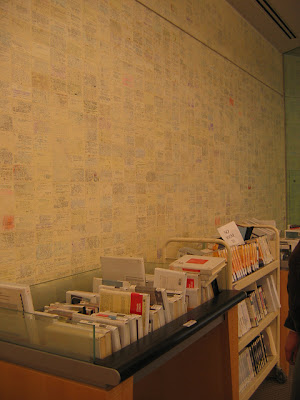 |
| Wall of catalog cards installed when the library moved to its current space in 1996 |
 |
| Temporary Main Library after Earthquake |
Compared
to other city institutions, the library faired rather well after the earthquake
when it came to rebuilding. Firstly,
they had a small insurance claim that they were able to call upon and secondly,
the Library Fund still had $40,000 that they were able to use to rebuild
(Wiley, 1996). The main library was
still considered to be a part of the city’s Civic
Center but plans for the library and Civic Center
were slow to develop. The library
actually had to fight to begin rebuilding because the Board of Supervisors
wanted to use the same property for the new City Hall even though the library
had owned it since 1903 (L. Bosc, 1968).
Fortunately for the library, the President of the trustees filed an
injunction against the Department of Public Works which forced the Board of
Supervisors into conceding and looking for a new spot for City Hall (L. Bosc,
1968). In June of 1907, construction
began on a temporary main library that would stand until the final plans for
the city’s Civic Center was complete (Wiley, 1996) The building was at the corner of Hayes and
Franklin (Wiley, 1996). The following
fiscal year, the library received its first appropriation that was over the
legal minimum and planning began on a bond measure that would help to fund the
new main library (Wiley, 1996).
 |
| Michael D. Young |
There
were efforts by Phelan to revive the original Civic Center
plans drawn up by Burnham prior to the earthquake, but a new sentiment was
growing in the city (Wiley, 1996).
Michael De Young, owner of the San
Francisco Chronicle, is credited as the voice of the effort to rebuild San Francisco with
business in mind; not beauty (Wiley, 1996).
But the plans for rebuilding the library, and the entire Civic Center
were slow moving and full of back and forth arguments. It wasn’t until the city was chosen as the
site for the official Panama-Pacific International Exhibition in 1911, that
there was a renewed sense of urgency in finishing the city’s Civic Center
(Wiley, 1996).
The
exhibition and a new mayor, James Rolph Jr., ushered in an era of development
which included the long awaited Civic
Center (Wiley,
1996). It was decided that the new Civic Center
would be built on the site of the old one since the city still owned the
property and after that decision was made, construction came quickly (Wiley,
1996). That is until a protestor
brought
up the Carnegie funds that were still on hold for the construction of a new
main library (Wiley, 1996). The plan was
to use some of the grant to fund construction of the new main library and the
remainder to build new branch libraries in the city (Wiley, 1996). The issue was hotly contested and ended up on
the November 1912 ballot (Wiley, 1996).
It passed and construction of the new Civic Center
continued. When it came time to draw up
plans for the library, the decision was made to trade the property that the
library owned for real estate that was closer and therefore better associated
with the new Civic
Center (Wiley,
1996). The official site of the new main
library was to be bounded by Larkin, McAllister, Hyde, and Fulton Streets
(Wiley, 1996). Now they just needed a
plan for the building itself.
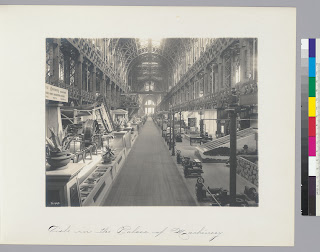 |
| Hall of Machinery - Panama Pacific Exhibition |
 |
| Preparing the ground for construction |
In 1913, the
library trustees arranged a competition to be judged by Phelan and two well
known architects; Cass Gilbert and Paul Philippe Cret (Wiley, 1996). Six local architects were chosen to enter,
and in 1914 the trustees announced George Kelham as the winner (San Francisco
Public Library, 2013). Kelham was
originally from Massachusetts and his first
job was at an architectural firm in New
York (Michelson, 2013). The firm sent him to San Francisco to supervise the rebuilding of
the Palace Hotel in 1906, and he remained once the project was complete
(Michelson, 2013). Aside from designing
the main library, Kelham was also the principal architect for the
Panama-Pacific International Exhibition and the principal architect for UC
Berkeley and UCLA (Michelson, 2013).
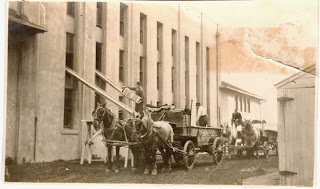 |
| Moving Books to the New Main Branch |
Kelham’s
design was a steel-framed granite structure that was designed to hold 500,000
books and have the capacity to expand to one million should the need arise
(Wiley, 1996). The exterior features
Roman arched windows set off by Ionic columns and though not part of the
original plan, five statues by Leo Lentelli were later added in the alcoves
between the columns (Wiley, 1996).
Patrons entered from Larkin
Street using three large, brass-framed doors that
led into a colonnaded vestibule (Wiley, 1996).
This led up to a broad staircase and the distribution room (Wiley, 1996). The vestibule, stairway, and delivery room
were all finished in travertine marble (Wiley, 1996). The delivery room, reference room, and the
main reading room all had painted beam ceilings and the doorways, bookcases,
and wooded fixtures were covered with an antique oak finish (Wiley, 1996). As one can see from the description, the
interior was designed to evoke an Italian Renaissance palazzo (Wiley,
1996).
 |
| Front Doors of New Main Branch |
The
library finally sold enough bonds to begin construction and on April 15, 1915
ground was broken (Wiley, 1996). Almost
immediately, lack of funds halted construction and it was not until they
borrowed the excess funds from the San Francisco Municipal Railroad that they
were able to resume construction (Wiley, 1996).
On April 16, 1916, a cornerstone laying ceremony took place and on
February 15, 1917 the library was finally completed and dedicated (Wiley,
1996). The main library would remain
here until 1996 when they moved, for a final time, into a larger building next
door (Wiley, 1996). The building Kelham
designed now houses
the Asian
Art Museum though you can
still see evidence of the library in the museum such as the quote above the
staircase which reads “Books bear the messages of the wisest of mankind to all
the generations of men” (Wiley, 1996).
 |
| Cornerstone Laying Ceremony 1916 |
The more
interesting developments in the library’s collection between 1906 and 1920, was
the 10,000 item music library that was purchased in 1911 from the Boston Music
Company and the rare books collection (Wiley, 1996). Both show a commitment to community groups, a
mentality that developed at the turn of the twentieth century in the library
field (Held, 1973). The music collection
purchase was arranged by Julius Rehn Weber who was a pianist and music teacher
in San Francisco
(Wiley, 1996). In 1920, at the
instigation of a library trustee named William Young, the library began to
systematically collect rare books and works of San Francisco’s fine printers (Wiley, 1996).
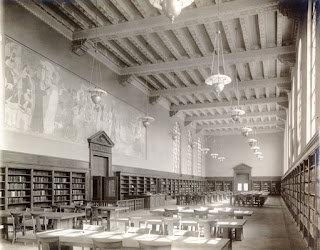 |
| Reading Room in the New Main |
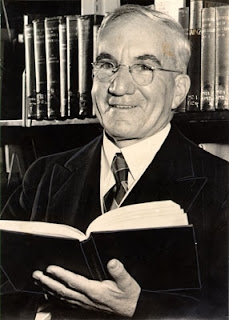 |
| Librarian Robert Rea |
William R.
Watson was hired as the city librarian after Clark
and his assistant Lichtenstein retired in 1906 (L. Bosc, 1968). He was the first trained professional
librarian to head the library (San Francisco Public Library, 2013). He was trained by Melvil Dewey (L. Bosc,
1968). He was also the head librarian
during a major milestone in library history.
During Watson’s service, the North
Beach branch bought a
collection of Italian language books and secured a spot as the first ever
library to cater to the needs of a minority group (Marco, 2012). Unfortunately, Watson was forced to retire in
1912 due to health reasons (Wiley, 1996).
He was succeeded by Robert Rea in 1913 (L. Bosc, 1968). Rea was a political appointee with no library
science training though he had worked at the library since the age of thirteen
(Wiley, 1996). He worked at the library
until 1945 and was a somewhat controversial because his career did not move
with the changing times. Rea grew up in
the library and it was the only job he ever had (Wiley, 1996). He presided over the construction of
seventeen new branches and, possibly his crowning career achievement, focused
and expanded the library’s collection (Wiley, 1996).
Unfortunately,
little has been said about the library assistants working during this era in
the library’s history. Library
assistants were no longer listed in municipal records or book bulletins and it
seems as though there is a lack of knowledge about the group in general. In the 1920s we get a better idea of the staff
culture though, unfortunately, it is not a positive one. For instance, in a letter to the Examiner written in 1920, a student
writes “It is about time the librarians…curb the chatter and patter of
lovenmeshed swains in their teens who come to use these places” (Wiley,
1996). Later in the 20s we learn that the
staff was mostly women and if a 1928 survey gives any clues, it would be safe
to assume the staff was not exemplary.
The board of trustees had requested an independent survey of the library
the resulting report was scathing, calling head librarian Robert Rea
“temperamentally unfitted for administrative
leadership” (Wiley, 1996). The remaining library staff faired no
better. The report found that the staff
was “almost entirely made up of women and that suffered from intellectual
inbreeding and lack of initiative because of the absence of encouragement for
the head librarian. There were also
serious shortcomings caused by the librarians’ lack of training, particularly
for librarians working with children” (Wiley, 1996). This shows that under Rea’s leadership,
though the library had substantially improved its collections, the focus on
training and professional leadership that the rest of the public library system
had promoted fell on deaf ears in San
Francisco.
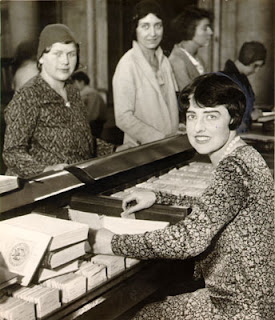 |
| Staff working at the Main Library 1930s |
After the
earthquake, the library grew. But the
library was spending less than any other library in the western region and had
one-third the staff to boot (Wiley, 1996).
During this time, civic improvement clubs continually petitioned for new
branches and eventually voted to increase the library’s budget so that they
could meet their user’s demands (Wiley, 1996).
In the fiscal year of 1907-08 the library’s appropriation was $64,445
but by 1921-22 the amount had grown to $185,282 (Wiley, 1996). Even still, the librarians who worked in San Francisco worked 42
hour weeks and were paid between $85-95 a month, the lowest wage of any other
city employee (Wiley, 1996).
The history of the
San Francisco Public library shows a great example of the birth and growth of
the public library movement as well as the trials and tribulations that so many
had to go through to keep the library going.
While on the one hand, the public library movement was popular in a city
of highly educated, civic minded individuals, the library also started at a
time when labor unrest was at its highest suggesting that the ruling elite was
looking for a way to quell the unrest.
The library buildings also suggest that there was a level of distrust of
those
corduroy wearing poor men as it was designed, like many other libraries,
to reduce access to the collection.
Despite its instant popularity, the library continually had issues (as
so many do even today) finding the funding to support its users and its
staff. Throughout the library’s history,
it was the lowest paying city job with the longest hours. But the librarians and staff remained
dedicated and the library thrived. In
the rebuilding of the library after the 1906 earthquake, we see evidence of the
library field’s move to user access and community commitment that continues
today. Unfortunately, the library’s
history is also one that is lacking in a minority presence. In examining the history of the San Francisco
Public library, one is reminded of the trails that public libraries are facing
today. Despite beginning the library
without a penny and with few worthwhile books in its collection, San Francisco still
managed to pull off a widely successful and sustaining public library. Throughout the library’s history, there was
constant ebb and flow of funding, properly trained staff, and public
interest. But despite these trials, the
library still continues to be an important civic
institution with 28 branches
and a 6-floor main library which is valued highly among its users. Over the last decade or so, libraries have
faced difficult decisions with changing technologies and the economic downturn
in the United States. But if the public library movement and the
San Francisco Public library can teach current librarians anything, it is that
perseverance is the key. The library is
about education of the masses (altruistic or not) and it seems that patience
and persistence will lead to the continuation of the library in some fashion as
it has for over 125 years in San Francisco.
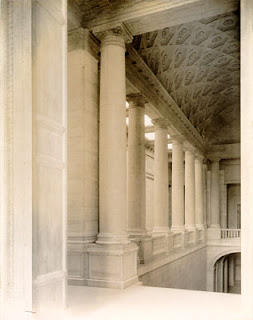 |
| Staircase in Main Library |
 |
| Current Main Library Building since 1996 |
Bacon, D. (2002). Walking
San Francisco
on the barbary coast trail. San
Francisco:
Quicksilver Press.
Bosc, G. (1968). A
history of the San Francisco
public library: 1878-1917. (Thesis). San
Jose
State University,
San Jose.
Bosc, L. (1968). A
history of the San Francisco
public library: 1917-1968. (Thesis). San
Francisco
State University,
San Jose.
California.
(n.d.). In Encyclopædia Britannica Online
Academic Edition. Retrieved from
http://www.britannica.com.libaccess.sjlibrary.org/EBchecked/topic/89503/Califor
nia
Casey, C. (2012, July 6). Architecture spotlight: San Francisco civic center
[web log
post]. Retrieved from http://untappedcities.com/2012/07/06/architecture-spotlight-san-francisco-civic-center/
Cheney, John
Vance. (n.d.). in American Authors, 1600-1900 [serial online]. Retrieved
from Biography Reference Bank. (W.H. Wilson).
Cutter, C. (1904). State Library
Associations. The Library Journal, 29.
Retrieved from
https://play.google.com/store/books/details?id=lsjgAAAAMAAJ&rdid=book-lsjgAAAAMAAJ&rdot=1
Davis, D. & Wiegnad, A. (1994). Library Equipment. In Encyclopedia of Library
History.
Retrieved from: http://books.google.com/books/about/Encyclopedia_of_
Library_History.html?id=WR9bsvhc4XMC
Held, R. (1973). The
rise of the public library in California.
Chicago:
American Library
Association.
Henry George Historical Society. (2009). Henry George.
Retrieved from http://henry
georgehistoricalsociety.org/henry_george
Image of Catalog Cards courtesy of nkuebrich via Flikr
Image of Dashaway hall courtesy of UC Berkeley, Bancroft
Library via Calisphere.
Retrieved from http://content.cdlib.org/ark:/13030/tf7p3009c8/
Image of E.D. Sawyer courtesy of Commercial Printing
House. Retrieved from
http://books.google.com/books/about/History_of_the_Bench_and_Bar_of_Californ.html?id=t-lYAAAAMAAJ
Image of Irving M. Scott courtesy of the New York Public
Library. Retrieved from
http://digitalgallery.nypl.org/nypldigital/id?3937855
Image of the Rudolph Continuous Index courtesy of Greenwood
Publishing Group.
Retrieved from http://books.google.com/books?id=QCddw5cVjVgC
&printsec=frontcover&source=gbs_ge_summary_r&cad=0#v=onepage&q&f=false
Images of San
Francisco City, the 1906 earthquake, Library buildings and grounds, Robert
Rea, James Phelan, and the 1930s library staff provided courtesy of the San Francisco
History
Center at the San
Francisco Public Library
Images not credited elsewhere are provided via WikiCommons
Marco, G. (2012). The
American public library handbook. Retrieved from:
http://books.google.com/books?id=_pB43PlC5mAC&printsec=frontcover&source=gbs_ge_summary_r&cad=0#v=onepage&q&f=false
Michelson, A. (2013). Kelham, George. Retrieved from https://digital.lib.washington.edu
/architect/architects/294/
Minton, T. (1996, September 5). Card catalog saved – But
S.F. library not sure where to
put it. SF Gate. Retrieved from http://www.sfgate.com/news/article/Card-Catalog-Saved-But-S-F-Library-Not-Sure-2967651.php
New York
Public Library. (2013). Irving M. Scott. Retrieved from http://digitalgallery
.nypl.org/nypldigital/id?3937855
San Francisco.
(n.d.). In Encyclopædia Britannica Online
Academic Edition. Retrieved
from http://www.britannica.com.libaccess.sjlibrary.org/EBchecked/topic/521129/
San-Francisco
San Francisco Board of Supervisors. (1880). San Francisco municipal reports
fiscal year
1879-80, Ending June 30, 1880. Retrieved from http://archive.org/details/sanfran
ciscomuni79sanfrich
San Francisco Board of Supervisors. (1895). San Francisco municipal
reports Fiscal Year
1894-95, Ending June 30, 1895.
Retrieved from http://archive.org/details/sanfranciscomuni45sanfrich
San Francisco
Call. (1906, September 19). Robert J. Tobin, banker, answers the call of
the angel of death. San Francisco Call. Retrieved from http://cdnc.ucr.edu/cdnc/
cgibin/cdnc?a=d&d=SFC19060919.2.98&cl=search&srpos=0&dliv=none&st=1&e=-------en-Logical-20--2878----America+Maru-all---
San Francisco
Public Library. (2013). Wall of Library Heroes. Retrieved from
http://sfpl.org/index.php?pg=2000060401
San Francisco
Public Library. (1900). Book bulletin,
volumes 6-8. Retrieved from
http://books.google.com/books/about/Book_Bulletin.html?id=Sh4zAQAAMAAJ
Shuck, O. (1901). History
of the bench and bar of California: Being biographies of many
remarkable
men, a store of humorous and pathetic recollections. Retrieved from http://books.google.com/books/about/History_of_the_Bench_and_Bar_of_Californ.html?id=t-lYAAAAMAAJ
Vassar, A. & Meyers, S. (2013). John S. Hagar. Retrieved
from http://www.join
california.com/candidate/7505
Wiley, P. (1996). A
free library in this city: the illustrated history of the San Francisco
public
library. San Francisco:
Weldon Owen, Inc.
